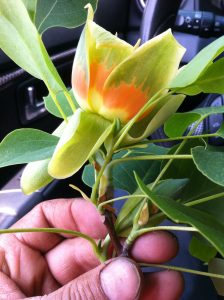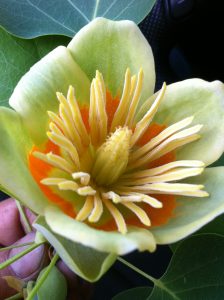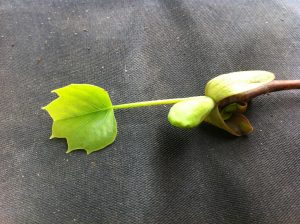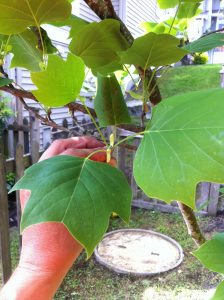It’s early May and tulip trees are hard to miss on one of my Maple Ridge strata sites. Liriodendron tulipifera (family Magnoliaceae) are eastern USA natives. In landscapes they are used as shade or lawn trees. They are large trees and therefore need ample space. Always consider your tree’s mature size. They are fast-growing trees but weak-wooded. This may be part of the reason why tulip trees are not recommended for street tree use. Then there is the size issue.
A little twist
Tulip trees bloom from May to June but there is an interesting twist. Trees usually flower and then leaf out. Cherries, for example, put on a great show, fade and then green foliage appears. Show is over. Tulip trees flower as they leaf out and since the cup-shaped tulip-like flowers are borne high in the trees, they are easy to miss. Not for me. Armed with this knowledge I was able to shoot my own flower pictures for this blog.
Tulip tree leaves also have an interesting tulip-like appearance. Together with the tulip-like flowers, it makes it easy to remember the common name. But remember it’s best to learn botanical names. You will be glad you did. Sometimes I find it amusing how both leaves and flowers are tulip-like. The actual leaf-out mechanism is interesting but difficult to describe.
Tulip trees like full sun and tolerate moderate drought conditions. In dry weather interior leaves turn yellow and fall off. This is a response to weather, not a disease.
One problem
One annoyance with tulip trees is aphids. When aphid infestations are large lots of honeydew secretions appear on the leaves. These provide the growing medium for sooty mold fungus. Usually there is little permanent damage to the tree but it is annoying. Mrs. Tushman goes out to get her latte and the family Porsche is covered in sticky secretions. Then the world is close to ending.
Tulip trees are gorgeous trees. Spot them in your neighborhoods. Plant them if you are lucky enough to have the required big spaces for it.









